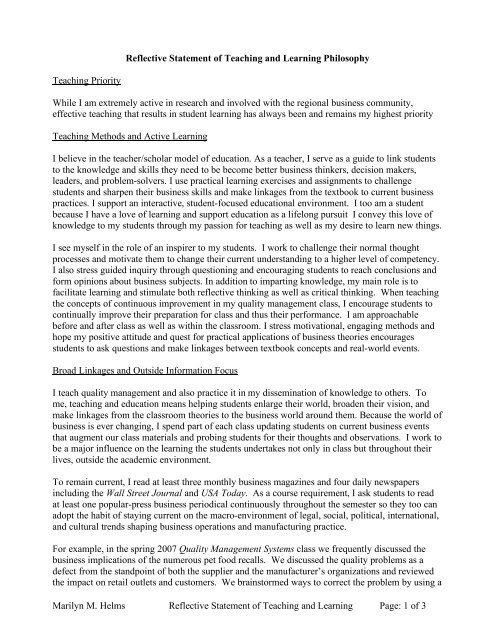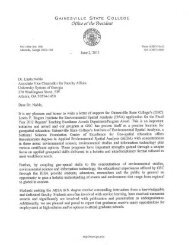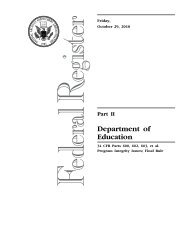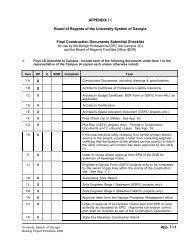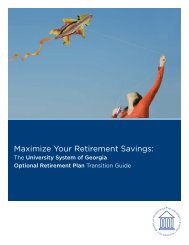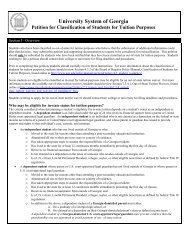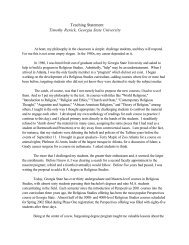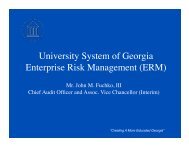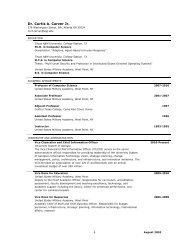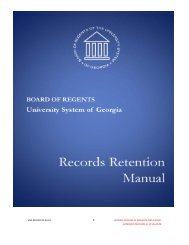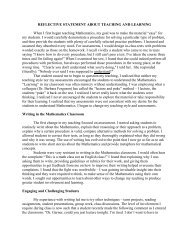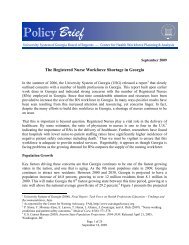Marilyn M. Helms Reflective Statement of Teaching and Learning ...
Marilyn M. Helms Reflective Statement of Teaching and Learning ...
Marilyn M. Helms Reflective Statement of Teaching and Learning ...
You also want an ePaper? Increase the reach of your titles
YUMPU automatically turns print PDFs into web optimized ePapers that Google loves.
<strong>Reflective</strong> <strong>Statement</strong> <strong>of</strong> <strong>Teaching</strong> <strong>and</strong> <strong>Learning</strong> Philosophy<br />
<strong>Teaching</strong> Priority<br />
While I am extremely active in research <strong>and</strong> involved with the regional business community,<br />
effective teaching that results in student learning has always been <strong>and</strong> remains my highest priority<br />
<strong>Teaching</strong> Methods <strong>and</strong> Active <strong>Learning</strong><br />
I believe in the teacher/scholar model <strong>of</strong> education. As a teacher, I serve as a guide to link students<br />
to the knowledge <strong>and</strong> skills they need to be become better business thinkers, decision makers,<br />
leaders, <strong>and</strong> problem-solvers. I use practical learning exercises <strong>and</strong> assignments to challenge<br />
students <strong>and</strong> sharpen their business skills <strong>and</strong> make linkages from the textbook to current business<br />
practices. I support an interactive, student-focused educational environment. I too am a student<br />
because I have a love <strong>of</strong> learning <strong>and</strong> support education as a lifelong pursuit I convey this love <strong>of</strong><br />
knowledge to my students through my passion for teaching as well as my desire to learn new things.<br />
I see myself in the role <strong>of</strong> an inspirer to my students. I work to challenge their normal thought<br />
processes <strong>and</strong> motivate them to change their current underst<strong>and</strong>ing to a higher level <strong>of</strong> competency.<br />
I also stress guided inquiry through questioning <strong>and</strong> encouraging students to reach conclusions <strong>and</strong><br />
form opinions about business subjects. In addition to imparting knowledge, my main role is to<br />
facilitate learning <strong>and</strong> stimulate both reflective thinking as well as critical thinking. When teaching<br />
the concepts <strong>of</strong> continuous improvement in my quality management class, I encourage students to<br />
continually improve their preparation for class <strong>and</strong> thus their performance. I am approachable<br />
before <strong>and</strong> after class as well as within the classroom. I stress motivational, engaging methods <strong>and</strong><br />
hope my positive attitude <strong>and</strong> quest for practical applications <strong>of</strong> business theories encourages<br />
students to ask questions <strong>and</strong> make linkages between textbook concepts <strong>and</strong> real-world events.<br />
Broad Linkages <strong>and</strong> Outside Information Focus<br />
I teach quality management <strong>and</strong> also practice it in my dissemination <strong>of</strong> knowledge to others. To<br />
me, teaching <strong>and</strong> education means helping students enlarge their world, broaden their vision, <strong>and</strong><br />
make linkages from the classroom theories to the business world around them. Because the world <strong>of</strong><br />
business is ever changing, I spend part <strong>of</strong> each class updating students on current business events<br />
that augment our class materials <strong>and</strong> probing students for their thoughts <strong>and</strong> observations. I work to<br />
be a major influence on the learning the students undertakes not only in class but throughout their<br />
lives, outside the academic environment.<br />
To remain current, I read at least three monthly business magazines <strong>and</strong> four daily newspapers<br />
including the Wall Street Journal <strong>and</strong> USA Today. As a course requirement, I ask students to read<br />
at least one popular-press business periodical continuously throughout the semester so they too can<br />
adopt the habit <strong>of</strong> staying current on the macro-environment <strong>of</strong> legal, social, political, international,<br />
<strong>and</strong> cultural trends shaping business operations <strong>and</strong> manufacturing practice.<br />
For example, in the spring 2007 Quality Management Systems class we frequently discussed the<br />
business implications <strong>of</strong> the numerous pet food recalls. We discussed the quality problems as a<br />
defect from the st<strong>and</strong>point <strong>of</strong> both the supplier <strong>and</strong> the manufacturer’s organizations <strong>and</strong> reviewed<br />
the impact on retail outlets <strong>and</strong> customers. We brainstormed ways to correct the problem by using a<br />
<strong>Marilyn</strong> M. <strong>Helms</strong> <strong>Reflective</strong> <strong>Statement</strong> <strong>of</strong> <strong>Teaching</strong> <strong>and</strong> <strong>Learning</strong> Page: 1 <strong>of</strong> 3
number <strong>of</strong> quality analysis tools including Ishikawa “fishbone” diagrams <strong>and</strong> completed a “House<br />
<strong>of</strong> Quality” to further analyze the problem.<br />
Classroom Activities<br />
To structure the classroom environment, I begin the first day by asking students to complete a short<br />
data sheet <strong>of</strong> their background, major, <strong>and</strong> future career plans. I have students introduce themselves<br />
<strong>and</strong> talk about their work experience <strong>and</strong> I also take a digital photo <strong>and</strong> prepare a photo roll so I can<br />
quickly learn their names. I give them my business card <strong>and</strong> we review the syllabus <strong>and</strong> even the<br />
scheduled assignments <strong>and</strong> when tests are scheduled. I think this is important because students<br />
appreciate the course structure <strong>and</strong> can better meet course objectives. I even discuss the types <strong>of</strong><br />
exams they will have as well as projects <strong>and</strong> quizzes.<br />
Typically I start with 10 minutes <strong>of</strong> coverage <strong>of</strong> campus announcements, business club activities,<br />
new job information, announcements <strong>of</strong> pr<strong>of</strong>essional organization meetings (local chapters <strong>of</strong> the<br />
American Society for Quality or the American Production <strong>and</strong> Inventory Control Society), <strong>and</strong><br />
discussion <strong>of</strong> current articles in the news. Next I have 15-20 minutes <strong>of</strong> lecture emphasizing<br />
material from the text. While PowerPoint slides are available on the course website for students’<br />
reference, I don’t use them in class. The remainder <strong>of</strong> the 45 minutes is for applying the textbook<br />
concepts through individual or small group exercises or homework review. I <strong>of</strong>ten ask small groups<br />
<strong>of</strong> students to compare their homework answers <strong>and</strong> then select one student from the group to work<br />
the problem on the board. Having students as well as myself explain how to work a production<br />
problem gives others additional insights.<br />
My teaching approach is one <strong>of</strong> application through examples, cases, exercises, <strong>and</strong> in-class<br />
activities. To stimulate the classroom learning environment, I use short video clips <strong>of</strong> plant tours<br />
<strong>and</strong> applications <strong>of</strong> current quality <strong>and</strong> manufacturing technologies, layouts, <strong>and</strong> production<br />
approaches. I encourage students to take part in business club activities on campus <strong>and</strong> <strong>of</strong>fer extra<br />
credit for their attendance at club meetings <strong>and</strong> plant tours.<br />
I ensure my class environment is structured for learning. I pay close attention to student’s facial<br />
expressions <strong>and</strong> reactions to determine if any are struggling with a concept. I work to use various<br />
words <strong>and</strong> phrases to explain the same concept. For students with little or no manufacturing work<br />
experience, I draw parallels using service industry examples. If students remain unsure <strong>of</strong> a topic, I<br />
<strong>of</strong>ten ask another student to rephrase the idea, using different words or various examples from their<br />
workplace to ensure students have a variety <strong>of</strong> choices linking the textbook topic to practice.<br />
<strong>Teaching</strong> Materials <strong>and</strong> Technology<br />
I use Georgia View/VISTA on-line course management s<strong>of</strong>tware for posting grades so students<br />
have immediate feedback on their tests, quizzes, <strong>and</strong> other assignments. Also available on the<br />
course website are PowerPoint slides, the course syllabus, other h<strong>and</strong>outs, <strong>and</strong> notes. I developed<br />
the material when I taught a hybrid format (one day in class/one on-line assignment) <strong>and</strong> an on-line<br />
class as part <strong>of</strong> the Web-based Bachelor <strong>of</strong> Applied Science Degree consortium.<br />
Student Club Sponsorship<br />
As faculty sponsor <strong>of</strong> two business clubs, Business Networking Club (open to all interested business<br />
<strong>Marilyn</strong> M. <strong>Helms</strong> <strong>Reflective</strong> <strong>Statement</strong> <strong>of</strong> <strong>Teaching</strong> <strong>and</strong> <strong>Learning</strong> Page: 2 <strong>of</strong> 3
students) <strong>and</strong> Sigma Beta Delta (international business honor society), I work to select appropriate<br />
speakers <strong>and</strong> tours to engage students <strong>and</strong> stimulate their interest. I also coordinate our senior<br />
luncheon for business graduates each May <strong>and</strong> conduct the honor society induction ceremony.<br />
Assist with Resumes <strong>and</strong> Student Job Search<br />
Students find their way to my <strong>of</strong>fice to have me take a “red pen” to their resume <strong>and</strong> cover letter as<br />
well as provide job search advice. I also teach three modules in our “Senior Seminar” (BUSA<br />
4700) course. This course was designed to prepare our graduating business seniors for the world <strong>of</strong><br />
work. In this class, I cover time management skills as well as resume preparation <strong>and</strong> interviewing<br />
strategies. At the end <strong>of</strong> the course, I review the resumes <strong>and</strong> assume the role <strong>of</strong> a Human Resources<br />
Director <strong>and</strong> conduct mock interviews with selected students. After the mock interview, I critique<br />
<strong>and</strong> praise their performance <strong>and</strong> discuss interviewing tips with the entire class. Students even stop<br />
by, or e-mail photos, asking for advice on interview attire. I encourage students to have mentors<br />
<strong>and</strong> role models so that the mentors’ achievement will inspire them. I enjoy following the progress<br />
<strong>of</strong> my students after college <strong>and</strong> it is rewarding to hear from students who are well into their<br />
pr<strong>of</strong>essional careers.<br />
Staying Current Through Research <strong>and</strong> Service<br />
My research concentrates on ways to improve business practices <strong>and</strong> I share my findings with my<br />
class. As a frequent speaker to local business organizations, I share business ideas <strong>and</strong> information<br />
learned from practitioners. <strong>Teaching</strong> also provides an opportunity to discuss my own research<br />
questions <strong>and</strong> findings that demonstrate <strong>and</strong> explain the course material.<br />
Grants <strong>and</strong> Travel to Support <strong>Teaching</strong> & Internationalization<br />
Because I value international study experiences, I wrote a U.S. Dept. <strong>of</strong> Education grant which<br />
included opportunities for student travel to Monterrey Mexico. I planned manufacturing plant tour<br />
to compliment lectures <strong>and</strong> developed an experiential scavenger hunt so students could quickly<br />
learn about cultural <strong>and</strong> international businesses over the ten day trip. This exercise was used as the<br />
basis for the publication I co-authored with Dalton State <strong>and</strong> University <strong>of</strong> Monterrey Mexico<br />
faculty -- A Fast Track to Cultural Immersion: The Scavenger Hunt, (2004) with M. Doyle <strong>and</strong> N.<br />
Westrup. Journal <strong>of</strong> <strong>Teaching</strong> in International Business, 15(4), 67-95. In addition, I participated in<br />
the 2002 University System <strong>of</strong> Georgia study experience to St. Petersburg <strong>and</strong> Moscow, Russia. I<br />
continue to use numerous product examples <strong>and</strong> business photos to help my students underst<strong>and</strong><br />
facets <strong>of</strong> global business <strong>and</strong> internationalization.<br />
<strong>Teaching</strong> Beyond Dalton State College – Junior Achievement<br />
I addition to my DSC teaching responsibilities, I serve on the Board <strong>of</strong> Directors for Junior<br />
Achievement <strong>and</strong> each fall <strong>and</strong> spring I teach third-grade classes at a nearby elementary school.<br />
The focus <strong>of</strong> this five-session module entitled “Our City” is to encourage students to graduate <strong>and</strong><br />
go on to college. We review various business careers, particularly entrepreneurship or new-venture<br />
creation, <strong>and</strong> discuss the educational skills a person would need to be successful in business. I<br />
always take DSC logo items to share with the class <strong>and</strong> hopefully, in ten years, I’ll have the<br />
opportunity to teach these future DSC business students again.<br />
<strong>Marilyn</strong> M. <strong>Helms</strong> <strong>Reflective</strong> <strong>Statement</strong> <strong>of</strong> <strong>Teaching</strong> <strong>and</strong> <strong>Learning</strong> Page: 3 <strong>of</strong> 3
MARILYN M. HELMS, D.B.A, CFPIM, CIRM, CQM/OE<br />
Sesquicentennial Endowed Chair <strong>and</strong> Pr<strong>of</strong>essor <strong>of</strong> Management, Dalton State College<br />
Complete vita is available at: www.daltonstate.edu/faculty/mhelms<br />
EDUCATION: Doctor <strong>of</strong> Business Administration degree in Management (1987), 3.94/4.00<br />
GPA. Dissertation: Strategy & the Impact <strong>of</strong> Environmental Pressures - An Analysis <strong>of</strong> the<br />
Expedited Small Package Industry). Also Master <strong>of</strong> Business Administration degree (1984) <strong>and</strong><br />
Bachelor <strong>of</strong> Business Administration degree (1982). University <strong>of</strong> Memphis (TN).<br />
TEACHING AND RESEARCH EXPERIENCE: Sesquicentennial Endowed Chair <strong>and</strong><br />
Pr<strong>of</strong>essor <strong>of</strong> Management, Dalton State College, Dalton, GA (8/00 to Present). <strong>Teaching</strong> Quality<br />
Management <strong>and</strong> Principles <strong>of</strong> Production/Operations Management. Work closely with the<br />
Northwest Georgia business community, encourage <strong>and</strong> co-author scholarly research with the<br />
business faculty <strong>and</strong> teach continuing education programs for the business community.<br />
ADDITIONAL TEACHING EXPERIENCE: (1) U.C. Foundation <strong>and</strong> Nation Centennial<br />
Pr<strong>of</strong>essor <strong>of</strong> Management <strong>and</strong> Director, Institute for Women as Entrepreneurs, University <strong>of</strong><br />
Tennessee at Chattanooga (7/87 to 7/00); (2) Faculdade de Economica, University <strong>of</strong> Coimbra,<br />
Portugal (4/00 to 6/00) on a Fulbright teaching <strong>and</strong> research grant; (3) Temple University<br />
Japan/Tokyo (1/00 to 2/00), teaching Entrepreneurship to Executive-MBA students.<br />
PROFESSIONAL CERTIFICATIONS: (1) Certified Manager <strong>of</strong> Quality/Organizational<br />
Excellence (CMQ/OE), American Society for Quality (ASQ), 2003; (2) Certified Integrated<br />
Resources Manager (CIRM), 1993 by APICS – the Association for Operations Management; (3)<br />
Certified Fellow in Production <strong>and</strong> Inventory Manager (CFPIM), 1991 by APICS.<br />
PROFESSIONAL AFFILIATIONS AND MEMBERSHIPS: Academy <strong>of</strong> International<br />
Business; Academy <strong>of</strong> Entrepreneurship; Academy <strong>of</strong> Management; American Production &<br />
Inventory Control Society; American Society for Competitiveness; American Society for<br />
Quality; Production & Operations Mgmt. Society; Society for the Advancement <strong>of</strong> Mgmt.;<br />
Society for Case Research; Decision Sciences Institute; European Operations Management<br />
Assn.; Institute for Supply Chain Management; <strong>and</strong> North American Case Research Association.<br />
AWARDS AND BOARD MEMBERSHIPS: (1) Faculty inductee, Sigma Beta Delta<br />
International Business Honor Society, Dalton State College, 2007; (2) Recipient <strong>of</strong> the 2006<br />
Dalton State College Foundation <strong>Teaching</strong> Excellence Award (One <strong>of</strong> 11 nominees for the first<br />
Award in 2005.); (3) University <strong>of</strong> Tennessee at Chattanooga Council <strong>of</strong> Scholars, 1998,<br />
recognizing research faculty, (4) Alpha Society, University <strong>of</strong> Tennessee at Chattanooga, spring<br />
1997, honors outst<strong>and</strong>ing faculty achievement, (5) Outst<strong>and</strong>ing Teacher Award Nominee, 1998,<br />
University <strong>of</strong> Tennessee National Alumni Association, (6) Outst<strong>and</strong>ing Teacher Award,<br />
University <strong>of</strong> Tennessee at Chattanooga School <strong>of</strong> Business, 1991, (7) U.C. Foundation<br />
Pr<strong>of</strong>essorship, 1989, for distinguished faculty, University <strong>of</strong> Tennessee at Chattanooga.<br />
MANUSCRIPT REVIEWER: for 19 peer-reviewed journals in manufacturing <strong>and</strong> quality.<br />
<strong>Marilyn</strong> M. <strong>Helms</strong> Condensed Curriculum Vitae Page: 1 <strong>of</strong> 3
PUBLICATIONS: Over 213 scholarly publications in referred, peer-reviewed journals since<br />
1987. Selected teaching-based research/scholarship includes:<br />
Encyclopedia <strong>of</strong> Management, 5 th ed., edited by <strong>Marilyn</strong> M. <strong>Helms</strong>. Farmington Hills, MI: Gale<br />
Group (a unit <strong>of</strong> The Thomson Company), 2005. Selected the 303 essay topics.<br />
Bluegrass Wedding Center Case (2007) with R. Becherer <strong>and</strong> J.H. Finch. Journal <strong>of</strong> the<br />
International Academy <strong>of</strong> Case Studies, 13(3), 7-18.<br />
Planning <strong>and</strong> Implementing Shared <strong>Teaching</strong>: An MBA Team <strong>Teaching</strong> Case Study, (2005)<br />
with J. Alvis <strong>and</strong> M. Willis. Journal <strong>of</strong> Education for Business. 81(1),<br />
September/October, 29-34.<br />
A Retention Assessment Process: Utilizing Total Quality Management Principles <strong>and</strong> Focus<br />
Groups, (2005) with H. Codjoe. Planning for Higher Education, 33(3), March-May, 31-<br />
42.<br />
A Stitch in Time... A Case Study <strong>of</strong> JN T-Shirts, (2005). with L.P Fletcher <strong>and</strong> M.Willis.<br />
Journal <strong>of</strong> the Academy <strong>of</strong> Business Education, spring, V6, 63-68.<br />
Anxiety <strong>and</strong> Career Action: The Impact <strong>of</strong> Contextual Factors on Graduating College Seniors,<br />
(2005) with M.B. Takeda <strong>and</strong> C. S. White. National Association <strong>of</strong> Colleges <strong>and</strong><br />
Employers (NACE) Journal, winter, 37-43.<br />
Management Science: Current Educational Trends <strong>and</strong> Jobs in the Field, (2005) with M. Ahmadi<br />
<strong>and</strong> K. Copel<strong>and</strong>. Scientific Journal <strong>of</strong> Administrative Development, Vol. 3, June, 56-78.<br />
Speaker’s Notes: A Low-Tech Change-Up Can Make Your Message St<strong>and</strong> Out, (2005).<br />
Presentations, July, 42.<br />
Increasing Creativity in Economics: The Service <strong>Learning</strong> Project, (2004). with A. Hervani.<br />
Journal <strong>of</strong> Education for Business 79(5), May/June, 267-274.<br />
Reasons to Remain in College: A Comparison <strong>of</strong> High School <strong>and</strong> College Students, (2004)<br />
with H. Codjoe <strong>and</strong> D. Mayo. Int. Journal <strong>of</strong> Educational Management, 18(6), 360-367.<br />
Experiential <strong>Learning</strong>: The Benefits <strong>of</strong> International Trade Shows for Marketing Students <strong>and</strong><br />
Faculty, (2003) with D. T. Mayo <strong>and</strong> J. Baxter. Special Global Marketing Education<br />
Issue <strong>of</strong> the Marketing Education Review, 13(3), fall, 17-25.<br />
Corporate Universities vs. Higher Education Institutions, (2002) with J. Nixon. Industrial <strong>and</strong><br />
Commercial Training, 34(4&5), 144-150.<br />
Business Students’ Perceptions <strong>of</strong> Faculty Evaluations, (2001) with F. Raiszadeh <strong>and</strong> M.<br />
Ahmadi. International Journal <strong>of</strong> Educational Management, 15(1), 12-22.<br />
Succeeding in the Education Accountability Environment—Tenure <strong>and</strong> Total Quality Management,<br />
(2001) with J. Nixon <strong>and</strong> A. Williams. Catalyst for Change, summer, 30(3), 11-15.<br />
TQM Principles <strong>and</strong> their Relevance to Higher Education: The Question <strong>of</strong> Tenure <strong>and</strong> Post-<br />
Tenure Review, (2001) with J. Nixon <strong>and</strong> A. Williams. The International Journal <strong>of</strong><br />
Education Management. 15(6/7), 322-331.<br />
Distance <strong>Learning</strong> Opportunities for Continuing Education, (2000) with M. Willis <strong>and</strong> B. Dodd.<br />
Continuing Higher Education Review, fall, V64, 67-76.<br />
How Students’ Salary Expectation Stack up Against Annual Earning, (2000). with M. Ahmadi,<br />
F. Raiszadeh, <strong>and</strong> T. Ross. Journal <strong>of</strong> Career Planning <strong>and</strong> Employment, winter, VLX<br />
(2), 37-43.<br />
Applied Business Training: The Latest Continuing Education for Physicians, (1999). with L.P.<br />
Fletcher <strong>and</strong> R. Blankenbaker. Health Care Managers, September, 18(1), 72-79.<br />
<strong>Marilyn</strong> M. <strong>Helms</strong> Condensed Curriculum Vitae Page: 2 <strong>of</strong> 3
Starting Salary Expectations <strong>of</strong> Undergraduate Students: Perception vs. Reality, (1999). with M.<br />
Ahmadi, T. Ross, <strong>and</strong> F. Raiszadeh <strong>and</strong> “Telecommuting: The Future Work<br />
Environment” with M. Ahmadi <strong>and</strong> T. Ross. July 1999 Proceedings <strong>of</strong> the International<br />
Decision Sciences Meeting.<br />
An Evaluation <strong>of</strong> Introductory MIS Textbooks Based on Readability Measures, (1998). with J.<br />
Nixon <strong>and</strong> M. Brabston. Journal <strong>of</strong> Information Systems Education, 9(1&2), 29-34.<br />
Case-Method <strong>Teaching</strong> in a Multi-Site Interactive Distance <strong>Learning</strong> Format, (1998). with J.<br />
Nixon. Education <strong>and</strong> Training, summer, 6(1), 86-92.<br />
An Examination <strong>of</strong> the Admission Criteria for MBA Programs: A Case Study, (1997). with M.<br />
Ahmadi <strong>and</strong> F. Raiszadeh. Education, summer, 177(4), 540-546.<br />
Development <strong>and</strong> Assessment <strong>of</strong> Effective <strong>Teaching</strong>: An Integrative Model for Implementation<br />
in Schools <strong>of</strong> Business Administration, (1997). with H. Finch & L.P. Ettkin, Quality<br />
Assurance in Education, 5(3), 159-165.<br />
Developing the Virtual Classroom: A Business School Example, (1997). with J. Nixon.<br />
Education + Training, 39(9), 349-353. Also reprinted in Issue 1 <strong>of</strong> Continuing<br />
Pr<strong>of</strong>essional Development an on-line journal at http://www.openhouse.org.<br />
OTHER INTELLECTUAL CONTRIBUTIONS:<br />
Newspaper Columns: Dalton Daily Citizen, monthly on Sundays, May 2001 to present.<br />
Published Cases <strong>and</strong> <strong>Teaching</strong> Exercises: 18<br />
Authored Study Guides <strong>and</strong> Ancillaries: 10<br />
Chapters <strong>and</strong> Readings in College Textbooks: 6<br />
Published Book Reviews: 9<br />
Newsletter Contributions: 17<br />
Pr<strong>of</strong>essional Presentations – International, Regional, National, <strong>and</strong> Local – 210 focusing on<br />
time management, total quality, customer service, <strong>and</strong> the value <strong>of</strong> education.<br />
GRANTS AND GRANT ACTIVITIES (1) Business <strong>and</strong> International Education Program, US<br />
Dept. <strong>of</strong> Education, Title VI-B. Awarded $179,000 for 2002-2004 to internationalize business<br />
programs <strong>and</strong> faculty at DSC as well as to provide seminars on exporting for the local business<br />
community. Attended grant directors meetings; Puerto Rico, June 26-28, 2002; (2) Awarded<br />
two consecutive US Department <strong>of</strong> Education, Title VI-B grants from 1992-1996 while at UT-<br />
Chattanooga representing combined awards totaling $372,646. Included signed agreements with<br />
public <strong>and</strong> private sector organizations. Activities included furthering international business<br />
education <strong>and</strong> undergraduate <strong>and</strong> graduate levels <strong>and</strong> building community expertise in exporting<br />
in the area. (3) Reviewer for US DOE Title 6B Programs since 1994.<br />
DIRECTORSHIP OF CENTERS: (1) Founding Director <strong>of</strong> CABS, the Center for Applied<br />
Business Services (fall 2000 to spring 2003). An outreach <strong>of</strong> the DSC Division <strong>of</strong> Business<br />
Administration to assist area companies with research projects <strong>and</strong> short-term data gathering<br />
assignments (2) Founding Director <strong>of</strong> the Institute for Women as Entrepreneurs (IWE) (January<br />
1995 to August 2000). An outreach <strong>of</strong> the UTC School <strong>of</strong> Business assisting area women <strong>and</strong><br />
minorities with new business ventures <strong>and</strong> moves to self-employment beginning with idea<br />
generation through business plan preparation. Volunteer consultants, faculty, <strong>and</strong> students<br />
assisted with one-on-one consulting <strong>of</strong> clients; scheduled seminars <strong>and</strong> banquets.<br />
<strong>Marilyn</strong> M. <strong>Helms</strong> Condensed Curriculum Vitae Page: 3 <strong>of</strong> 3
Direct Documentation <strong>of</strong> Student <strong>Learning</strong><br />
I have linked documentation <strong>of</strong> student learning to my personal teaching goals. Unless<br />
indicated, quoted material is from recent student evaluation <strong>of</strong> me <strong>and</strong> my courses.<br />
• Be fair but dem<strong>and</strong>ing; engaging but rigorous. Student comments including “I learned a lot<br />
<strong>of</strong> information I knew nothing about <strong>and</strong> would not have known that I needed to know it” or<br />
“One <strong>of</strong> the best instructors I have ever had the privilege <strong>of</strong> learning from” or “She is<br />
dynamic <strong>and</strong> presents herself as a pr<strong>of</strong>essional. She invites participation; never boring.”<br />
• Strive for continuous improvement in the classroom. Evidence <strong>of</strong> student improvement over<br />
time on tests <strong>and</strong> exercises confirms this learning as does the student comment “The course<br />
was very challenging. I enjoyed the challenge <strong>of</strong> learning this material. Dr. <strong>Helms</strong><br />
performed excellent by inspiring interest in the material. She presented material I related to<br />
the real world.”<br />
• Remain organized <strong>and</strong> follow the posted schedule <strong>of</strong> homework <strong>and</strong> exam dates I include in<br />
each syllabus. Students <strong>of</strong>ten comment I’m the first pr<strong>of</strong>essor to complete an entire textbook.<br />
I know this is important in a principles class since students will be asked to assess <strong>and</strong> apply<br />
this information in subsequent courses. Students comment on a feeling <strong>of</strong> accomplishment<br />
after having completed their text.<br />
• Maintain appropriate control <strong>and</strong> structure in the classroom to facilitate learning. Students<br />
comment I am organized, strict but fair, <strong>and</strong> effectively use their classroom time.<br />
• Advise students in <strong>and</strong> out <strong>of</strong> the classroom (current <strong>and</strong> former as well) on careers, on-going<br />
educational options, graduate programs, presume <strong>and</strong> cover letter preparation <strong>and</strong> job search<br />
strategies. It is rewarding to hear from students who are well into their pr<strong>of</strong>essional careers.<br />
I edit <strong>and</strong> critique at least four student resumes per week <strong>and</strong> assist them with dress,<br />
grooming, mock-interviews, where we role play common interview questions <strong>and</strong> answers.<br />
Students spread the word about the benefit <strong>of</strong> this assistance <strong>and</strong> other students feel free to<br />
ask for help, even students outside the division <strong>of</strong> business administration.<br />
• Stay as current as today’s newspaper on real-world business topics. Students have<br />
commented “She uses great examples,” or “Effective communicator loves the subject <strong>and</strong><br />
always bringing outside material to share” or “I liked that the course was more open<br />
discussion instead <strong>of</strong> pure lecture. She always presents the material well <strong>and</strong> attempts to use<br />
different methods <strong>of</strong> presentation.”<br />
• Invite quest speakers from the area to my class or schedule field trips to showcase business in<br />
practice. A student commented “The field trip to Roper (appliance manufacturer) showed<br />
how this class is used in business.”<br />
• Utilize group activities, cases, <strong>and</strong> vignettes rather than a lecture-only format. A student<br />
commended “I always enjoy Dr. <strong>Helms</strong>, all <strong>of</strong> her courses are well taught. She never<br />
ventures <strong>of</strong>f subject <strong>and</strong> she makes almost every subject interesting.”<br />
• Assess student learning <strong>and</strong> mastery <strong>of</strong> course concepts beyond testing to include class<br />
participation <strong>and</strong> short quizzes. To ensure student learning, I use short quizzes that quickly<br />
<strong>and</strong> effectively reinforce major course concepts. Because <strong>of</strong> the r<strong>and</strong>om schedule <strong>of</strong> the<br />
quizzes, student attendance, participation, test scores <strong>and</strong> overall learning have improved. As<br />
a student comment indicated: “I like the quizzes. They are useful in improving my grades.”<br />
• Other evidence <strong>of</strong> teaching success includes the growth in the number <strong>of</strong> business<br />
administration majors at Dalton State College <strong>and</strong> evidence <strong>of</strong> the progress <strong>of</strong> these students.<br />
<strong>Marilyn</strong> M. <strong>Helms</strong> Direct Documentation <strong>of</strong> Student <strong>Learning</strong> Page: 1 <strong>of</strong> 2
Frequent cards, notes <strong>and</strong> e-mails (see two example below) from former students about their<br />
job <strong>and</strong> graduate education progress serve as documentation <strong>of</strong> the value <strong>of</strong> my teaching <strong>and</strong><br />
our business educational program. The students’ promotions, job success, <strong>and</strong> options serve<br />
to validate my teaching effectiveness.<br />
Date: Fri, 27 Apr 2007 11:04:24 -0400 (EDT)<br />
From: "Jennifer Lynn Wright" Block Address<br />
Subject: Jenny Wright<br />
To: mhelms@daltonstate.edu<br />
Dr. <strong>Helms</strong>,<br />
Thanks for a great semester! I really appreciate how organized your<br />
class is, <strong>and</strong> all the different activities you had for us to keep the<br />
class interesting. I definitely appreciate how very quickly you always<br />
get our grades posted. Enjoy your summer!<br />
Date: Wed, 21 Jun 2006 18:45:51 -0700 (PDT)<br />
From: "Gracian Mitcham" Block Address<br />
Subject: Re: Hello Dr. <strong>Helms</strong>!<br />
To: "Dr. <strong>Marilyn</strong> M. <strong>Helms</strong>" <br />
How are you In case you are wondering, this is your wonderful former student,<br />
Gracian Mitcham now, Gracian Williamson. Hope things are well with<br />
you <strong>and</strong> your family.<br />
I am doing great. I recently got married, hence the name change. I<br />
wanted to touch bases with you to ask if it was okay that I use you for<br />
a reference. I am applying for an Assistant Director <strong>of</strong> Admissions<br />
position at Mercer University, here in Atlanta. I am really excited<br />
about the position because I believe it will be a great opportunity for<br />
me! I look forward to hearing from you!<br />
In fall 2006 as part <strong>of</strong> my post-tenure review, three faculty peers sat in on three <strong>of</strong> my<br />
classes <strong>and</strong> prepared their assessment after reviewing course syllabi, sample tests, h<strong>and</strong>outs, <strong>and</strong><br />
my statement <strong>of</strong> teaching philosophy. Two members <strong>of</strong> the team taught outside the division <strong>of</strong><br />
business administration. The following is taken from their 11/26/06 report: As one observer<br />
noted, “she excels at this; this is her classroom, without being dictatorial or overbearing.” She<br />
creates an environment that is conducive to learning. She calls on students by name <strong>and</strong> asks<br />
questions that engage the students in discussions. As one observer stated, she “integrates recent<br />
data from sources into the class, <strong>and</strong> this stimulates many students to <strong>of</strong>fer comments which<br />
relate directly to course objectives.” She has “high expectations for students, but in a<br />
supportive <strong>and</strong> patient environment.” The students remained focused even though the class was<br />
a night class.<br />
In summary, as the recipient <strong>of</strong> the 2006 Dalton State College Foundation <strong>Teaching</strong><br />
Excellence Award (<strong>and</strong> one <strong>of</strong> 11 Dalton State College faculty nominated the first time the award<br />
was given in 2005), I am confident my teaching practices are working for the benefit <strong>of</strong> my<br />
students.<br />
<strong>Marilyn</strong> M. <strong>Helms</strong> Direct Documentation <strong>of</strong> Student <strong>Learning</strong> Page: 2 <strong>of</strong> 2
Excerpt from Course Syllabus<br />
Spring Semester 2007 Sections 30 - OPMT 4503 Quality Management Systems<br />
20775 7:35 p.m. to 8:50 p.m. T/Th Memorial Building Room 119<br />
Dr. M. M. <strong>Helms</strong>, CFPIM, CIRM, Certified Quality Manager<br />
Sesquicentennial Endowed Chair <strong>and</strong> Pr<strong>of</strong>essor <strong>of</strong> Management<br />
Office:<br />
Memorial G7<br />
Phone Numbers: Office: 706-272-2600 (Answering Machine)<br />
Fax: 706-272-4525 (University Fax Machine)<br />
Home: 706-935-8848 (Answering Machine)<br />
I can also be reached before or after class, by chance, <strong>and</strong> other times by appointment.<br />
Please feel free leave a message <strong>and</strong> I will return your call promptly.<br />
TEXT AND SUPPORT MATERIALS:<br />
1. The Management <strong>and</strong> Control <strong>of</strong> Quality, 6/E, James R. Evans <strong>and</strong> William M. Lindsay,<br />
ISBN: 0-324-20223-7, Publisher: South-Western, Copyright: 2005<br />
2. Wall Street Journal, Quality Progress, Business Week, Industry Week <strong>and</strong>/or Fortune. You<br />
should read at least one business periodical to read continuously throughout the semester. Be<br />
prepared to update our class on current quality issues continuously throughout the semester.<br />
COURSE DESCRIPTION: This course develops the continuous quality philosophy. Strategic<br />
quality management focuses on assessment <strong>and</strong> group decisions. The role <strong>of</strong> leadership in<br />
continuous quality improvement is covered in quality pr<strong>of</strong>iles <strong>and</strong> cases. Tools for process<br />
management <strong>and</strong> statistical process control are included.<br />
STUDENT ASSESSMENT AND EVALUATION:<br />
20% Exam 1 (Chapters1-3) (objective, short essay & problems)<br />
20% Exam 2 (Chapters 4-6) (objective, short essay & problems)<br />
20% Exam 3 (Chapters 7-9) (objective, short essay & problems)<br />
20% Exam 4 (Chapters 10-14) (objective, short essay & problems)<br />
5% Conscious consumerism project <strong>and</strong> presentation<br />
15% Quizzes, homework, in-class exercises, <strong>and</strong> outside articles<br />
100% Total<br />
STUDENT LEARNING OUTCOMES<br />
• To articulate underst<strong>and</strong>ings <strong>of</strong> course materials acquired through listening, reading,<br />
graphics, computations, practice, <strong>and</strong> electronic media;<br />
• To organize <strong>and</strong> communicate scientific knowledge <strong>and</strong> ideas about quality in a logical <strong>and</strong><br />
purposeful manner as appropriate;<br />
• To utilize appropriate models, tools, <strong>and</strong> concepts to solve qualitative <strong>and</strong> quantitative quality<br />
problems (including using data from text package, spreadsheets, <strong>and</strong> s<strong>of</strong>tware packages);<br />
• To perform mathematical <strong>and</strong> statistical operations to solve quality problems;<br />
• To underst<strong>and</strong> the quality philosophy <strong>and</strong> its importance to international competitiveness;<br />
<strong>Marilyn</strong> M. <strong>Helms</strong> Sample Course Syllabus Page: 1 <strong>of</strong><br />
2
• To underst<strong>and</strong> quality organizations, awards, <strong>and</strong> certifications <strong>and</strong> their importance;<br />
• To demonstrate underst<strong>and</strong>ing <strong>of</strong> the course topics <strong>and</strong> materials through performance on<br />
tests, presentations <strong>and</strong> in-class exercises <strong>and</strong> case analysis.<br />
Quizzes, Homework, Class Participation: You must be present in class to be eligible to take any<br />
in-class quizzes (individual or team) or to get credit for any assigned homework collected. If<br />
you are late to class, you will not receive extra time to complete the quiz. You are expected to<br />
contribute to the class discussions <strong>and</strong> bring articles <strong>and</strong> information to share with the class.<br />
CLASS AND ASSIGNMENT SCHEDULE<br />
Date Assignment Homework (in addition to<br />
reading/studying all <strong>of</strong> the assigned<br />
chapter material)<br />
T Jan 9 Introduction Complete data sheet & review syllabus.<br />
Th Jan 11 Chapter 1:<br />
Introduction to Quality<br />
T Jan 16 Chapter 2:<br />
Total Quality in Organizations<br />
Th Jan 18 Chapter 3:<br />
Philosophies <strong>and</strong> Frameworks<br />
T Jan 23 Chapter 3:<br />
Philosophies <strong>and</strong> Frameworks<br />
Th Jan 25 Exam 1 (Ch # 1-3)<br />
T Jan 30 Review Exam 1<br />
Chapter 4: Focusing on<br />
Customers<br />
Th Feb 1 Chapter 5:<br />
Leadership <strong>and</strong> Strategic<br />
Planning<br />
T Feb 6 Chapter 6:<br />
Human Resource Practices<br />
Th Feb 8 Exam 2 (Ch # 4-6)<br />
T Feb 13 Review Exam 2<br />
Chapter 7: Process Management<br />
p. 41 Project 1. Bring 3 examples <strong>of</strong><br />
advertisements stressing quality to class <strong>and</strong><br />
Case III A Total Quality Business Model<br />
Case: Ritz Carlton, pp. 78-79.<br />
Problems 2, 4, 6, 7, 8, <strong>and</strong> 9.<br />
Study the philosophies <strong>of</strong> the various quality<br />
gurus pr<strong>of</strong>iled in Chapter 3. Be able to<br />
differentiate the contributions <strong>of</strong> each.<br />
Visit the Baldrige website at<br />
http://www.quality.nist.gov/Award_Recipien<br />
ts.htm <strong>and</strong> select a winning company (from<br />
any year) you are not familiar with. Write a<br />
3-paragraph pr<strong>of</strong>ile <strong>of</strong> the key traits that led<br />
this company to win the coveted Baldrige<br />
award.<br />
Case: Gold Star Chili <strong>and</strong> bring an example<br />
<strong>of</strong> a customer feedback mechanism to class<br />
(customer comment card, survey, etc.)<br />
Cases Johnsonville Foods, A Strategic<br />
Bottleneck <strong>and</strong> Corryville Foundry Company<br />
Case: LL Bean, pp. 297-299<br />
Problems: 2, 3, <strong>and</strong> 8<br />
Case: Gold Star Chili, pp. 354-357<br />
Th Feb 15 Chapter 7: Process Management Bring outside article on process management.<br />
<strong>Marilyn</strong> M. <strong>Helms</strong> Sample Course Syllabus Page: 2 <strong>of</strong><br />
2
Course H<strong>and</strong>out - Conscientious Consumerism<br />
Project <strong>and</strong> Participation: Evaluating a Firm’s Response to Poor Quality<br />
How many times have you used a product only to find that it didn’t meet your original<br />
expectations Perhaps it was falsely advertised, misrepresented, or failed to perform due to<br />
design or workmanship problems. Have you visited a restaurant only to get poor service, poor<br />
quality food, or even the wrong order Have you been through a drive-thru window only to find<br />
something was missing Have you had a bad experience in a department store or other retail<br />
establishment Did you take the time to alert management Most people don’t but should.<br />
Successful production <strong>and</strong> operations strategies must be based on the premise <strong>of</strong> consistent<br />
quality to consumers. Managers manufacturing <strong>and</strong> service operations must continually monitor<br />
<strong>and</strong> use consumer feedback in planning <strong>and</strong> control process. This information can help<br />
organizations better design operations to serve the consumer. Consumers also have an obligation<br />
to voice concerns (<strong>and</strong> praises) to the companies we patronize. If we do not, firms will not have<br />
feedback on how to change or improve their products, services or procedures.<br />
Now is your chance (or your motivation) to respond to poor quality. Let a company know about<br />
a recent bad product or service encounter. Your assignment is to write a letter or e-mail to the<br />
proper person(s) about your problem. (You can also fill out a complaint card if available, but<br />
write an additional letter to go along with it.) Save copies <strong>of</strong> your letters for presentation to the<br />
class along with a brief (10-minute) presentation about your poor quality product or service <strong>and</strong><br />
how the company h<strong>and</strong>led it. Hopefully, if the company cares about its customers <strong>and</strong> the<br />
company's reputation, you will get a response from your complaint. Be sure to make a copy to<br />
show the class. Also prepare a timeline to document the correspondence <strong>and</strong> complaint h<strong>and</strong>ling<br />
process. Select your product or service issue by spring break. You will need to complete this<br />
project early enough to allow time for a response. If you do not receive one before this<br />
assignment is due, please call the company directly <strong>and</strong> record your verbal conversation.<br />
For your oral PowerPoint presentation, discuss your problem, your initial action <strong>and</strong> follow-up<br />
actions or solutions. Bring copies <strong>of</strong> all correspondence <strong>and</strong> a summary <strong>of</strong> any phone<br />
conversations to class to h<strong>and</strong> in. You may want to make copies <strong>of</strong> your letters for the class or<br />
prepare a time line <strong>of</strong> the events. Discuss how the company h<strong>and</strong>led the situation <strong>and</strong> discuss<br />
their strengths <strong>and</strong> weaknesses in responding to you. Write a final letter to the company. Tell<br />
them while you actually experience a bad product or service you responded in large part because<br />
this was an assignment in your Quality Management Systems class. Close the letter by sharing<br />
your suggestions <strong>and</strong> ideas for improving the way they h<strong>and</strong>le customer complaints. Bring a<br />
copy <strong>of</strong> this letter to class on the day <strong>of</strong> your presentation to h<strong>and</strong> in <strong>and</strong> bring copies for the<br />
class to review. Mail your letter to the company CEO certified, registered mail (with return<br />
receipt requested). Instructions are at your local post <strong>of</strong>fice. Include a copy <strong>of</strong> this postal receipt<br />
with your letter.<br />
Be prepared to critique the firm’s complaint h<strong>and</strong>ling process <strong>and</strong> evaluate the speed <strong>of</strong> h<strong>and</strong>ling<br />
your problem. We’ll discuss these in class after your presentation. We’ll also discuss whether<br />
you are more likely to complain after this assignment. In addition, each May I write a summary<br />
<strong>of</strong> your experiences in my Dalton Daily Citizen newspaper column.<br />
<strong>Marilyn</strong> M. <strong>Helms</strong> Quality Management System Course H<strong>and</strong>out – Project Page: 1 <strong>of</strong> 1
Name: _________________________________________ Date:________________________<br />
Test 4 Chapter 10-13 IOMG 3251 Dr. <strong>Helms</strong><br />
Questions 1-60 are worth 1 point each. Four essay questions <strong>and</strong>/or problems are worth 10 points each.<br />
____32. If the average aggregate inventory value is $45,000 <strong>and</strong> the cost <strong>of</strong> goods sold is $10,000,<br />
which <strong>of</strong> the following is weeks <strong>of</strong> supply<br />
A. 45,000<br />
B. 234<br />
C. 120<br />
D. 23.4<br />
E. 4.5<br />
____35.<br />
____36.<br />
____40.<br />
____44.<br />
Which <strong>of</strong> the following terms best describes the ability <strong>of</strong> a company to deliver highly<br />
customized products <strong>and</strong> services to different customers around the world<br />
A. Customization<br />
B. High customization<br />
C. Mass customization<br />
D. Global sourcing<br />
E. Outsourcing<br />
If the best operating level <strong>of</strong> a piece <strong>of</strong> equipment is at a rate <strong>of</strong> 400 units per hour <strong>and</strong> the<br />
actual output during an hour is 300 units, which <strong>of</strong> the following is the capacity utilization<br />
rate<br />
A. 0.75<br />
B. 1.00<br />
C. 1.33<br />
D. 2.33<br />
E. 300<br />
At a decision point in a decision tree, which machine would you select when trying to<br />
maximize pay<strong>of</strong>f when the anticipated benefit <strong>of</strong> selecting machine A is $45,000 with a<br />
probability <strong>of</strong> 90%; the expected benefit <strong>of</strong> selecting machine B is $80,000 with a<br />
probability <strong>of</strong> 50% <strong>and</strong> the expected benefit <strong>of</strong> selecting machine C is $60,000 with a<br />
probability <strong>of</strong> 75%<br />
A. Machine A<br />
B. Machine B<br />
C. Machine C<br />
D. You would be indifferent between machines A <strong>and</strong> C<br />
E. You would be indifferent between machines A <strong>and</strong> B<br />
Plant A is located at the (X, Y) coordinates <strong>of</strong> (100, 200) <strong>and</strong> has a volume <strong>of</strong> shipping <strong>of</strong><br />
500 units a day. Plant B is located at the (X, Y) coordinates <strong>of</strong> (150, 400) <strong>and</strong> has a volume<br />
<strong>of</strong> shipping <strong>of</strong> 200 units a day. Using the Centroid method, which <strong>of</strong> the following is the X<br />
coordinate for the new plant location<br />
A. About 100<br />
B. About 115<br />
C. About 130<br />
D. About 150<br />
E. X coordinate can not be computed from the data given<br />
<strong>Marilyn</strong> M. <strong>Helms</strong> Sample Exam Questions for Production/Operations Management Page: 1 <strong>of</strong> 2
Essay:<br />
1. Compare <strong>and</strong> contrast qualitative <strong>and</strong> quantitative forecasting methods. Discuss when to use each type<br />
<strong>of</strong> forecast <strong>and</strong> why<br />
Problems - Note: Please show your work for partial credit.<br />
2. (Chapter 10) Calculate the break-even product value <strong>of</strong> using Express Mail (overnight delivery)<br />
versus Parcel Post (3-day delivery) for sending a package from Dalton, GA to San Francisco, CA.<br />
The following table contains the appropriate costs. Assume that inventory carrying cost is 25<br />
percent <strong>of</strong> the product value <strong>and</strong> there are 365 days in the year (Item value = 365 x shipping<br />
savings/(carrying costs x days saved). Which shipping method is best Why<br />
Shipping Weight Overnight Cost Cost 3-day Savings Break-Even Break-Even<br />
Per pound<br />
2 $15.50 $4.50<br />
4 $20.40 $6.28<br />
6 $24.56 $7.98<br />
8 $25.69 $8.49<br />
10 $27.89 $9.56<br />
12 $30.39 $9.98<br />
3. (Chapter 12) McDonald’s fast-food sells an average <strong>of</strong> 4,000 Quarter Pound (1/4 lb.) burgers each<br />
week (which equals 1,000 pound <strong>of</strong> meet). Hamburger patties are re-supplied twice a week <strong>and</strong> on<br />
average the store has 350 pounds <strong>of</strong> hamburger in stock. Assume that the hamburger costs $1.00<br />
per pound at their wholesale rate. [Note Inventory turnover = annual COGS/Average Aggregate<br />
Inventory Value; Days <strong>of</strong> Supply = (Average Aggregate Inventory Value/COGS) x 365 days).<br />
(Chapter 10)<br />
a. What is the yearly inventory turnover for the hamburger patties<br />
b. On average, how many days <strong>of</strong> supply are on h<strong>and</strong><br />
4. (Chapter 13) Historical dem<strong>and</strong> for a product is as follows:<br />
April 60<br />
May 55<br />
June 75<br />
July 60<br />
August 80<br />
September 75<br />
a. Using a simple four-month moving average, calculate a forecast for October.<br />
[Ft=(A t-1 + A t-2 + A t-3 + A t-n)/n]<br />
b. Using single exponential smoothing with an alpha <strong>of</strong> 0.2 <strong>and</strong> a September forecast <strong>of</strong> 65,<br />
calculate a forecast for October. [Ft = Ft-1 + α(At-1 – Ft-1)] How could you determine<br />
which forecasting method is the most accurate<br />
<strong>Marilyn</strong> M. <strong>Helms</strong> Sample Exam Questions for Production/Operations Management Page: 2 <strong>of</strong> 2
STUDENT EVALUATION OF FACULTY SUMMARY<br />
Likert Response Scale Ranges from a low <strong>of</strong> 1 “Strongly Disagree” to a high <strong>of</strong> 5 “Strongly Agree”<br />
Semester Fall 2006 Spring 2006 Fall 2005 Spring 2005 Fall 2004 Spring 2004 Fall 2003<br />
Course 3251D 3251N 4503N 3251N 3251D 3251N 4503N 4503D 4501D 4501N 4503N 4503D 4501N 4501D<br />
Uses class 4.8 4.885 4.879 5 4.783 4.933 4.667 4.929 4.86 4.71 4.47 4.40 4.78 4.63<br />
time<br />
effectively<br />
Understood 5 4.923 4.758 5 4.957 4.933 5 4.929 5 5 4.87 5 4.94 4.88<br />
policies <strong>and</strong><br />
grading<br />
Presentation 4.85 4.769 4.727 4.917 4.826 4.667 4.667 4.929 4.86 4.57 4.87 4.90 4.89 5<br />
orderly <strong>and</strong><br />
clear<br />
Opportunity 5 4.885 4.788 5 4.87 4.933 4.667 4.857 5 4.57 4.93 5 4.89 5<br />
to ask<br />
questions<br />
Work was 4.95 4.923 4.909 5 4.957 5 5 4.857 5 4.86 5 4.80 4.94 5<br />
graded<br />
fairly<br />
Courteous 4.95 4.962 4.939 5 5 5 5 5 4.86 5 4.80 4.90 4.89 5<br />
attitude<br />
Effective<br />
Instructor<br />
4.75 4.846 4.879 4.917 4.957 4.8 4.667 4.929 5 4.86 4.93 5 5 5<br />
Key:<br />
3251 = Principles <strong>of</strong> Operations Management (required business core course for – junior level)<br />
4503 = Quality Management Systems (upper division elective course, IOMG 3251 is a prerequisite – junior or senior level)<br />
4501 = Entrepreneurship (upper division elective course – junior or senior level)<br />
D = Day Course<br />
N = Night Course<br />
Note: At the end <strong>of</strong> each semester, I review these evaluations including my numerical scores <strong>and</strong> the students’ open-ended comments. I value<br />
comments <strong>and</strong> feedback <strong>and</strong> continuously work to improve my courses to <strong>of</strong>fer the maximum learning potential for my students.<br />
<strong>Marilyn</strong> M. <strong>Helms</strong> Student Evaluation Summary Page 1 <strong>of</strong> 1
April 29, 2007<br />
Dr. Dorothy Zinsmeister<br />
Assistant Vice Chancellor for Academic Affairs<br />
Board <strong>of</strong> Regents <strong>of</strong> the University System <strong>of</strong> Georgia<br />
270 Washington St., SW<br />
Atlanta, GA 30334-1450<br />
Dr. Zinsmeister,<br />
I am writing you to share some <strong>of</strong> my thoughts concerning the work <strong>of</strong> Dr. <strong>Marilyn</strong><br />
<strong>Helms</strong> at Dalton State College. I received my Bachelors Degree from Dalton State<br />
College in 2003, <strong>and</strong> Dr. <strong>Helms</strong> was one <strong>of</strong> my Pr<strong>of</strong>essors within the IOMG Program. As<br />
a student <strong>of</strong> Dr. <strong>Helms</strong>, I saw first-h<strong>and</strong> her commitment to educational excellence <strong>and</strong><br />
her commitment to her student’s success in the classroom <strong>and</strong> in the workforce. Dr.<br />
<strong>Helms</strong> employed many different resources including textbooks, real life examples, <strong>and</strong><br />
discussions <strong>of</strong> current business events to help her students not only learn but, more<br />
importantly, be able to apply their knowledge in the business world. Dr. <strong>Helms</strong> always<br />
made herself available to her students <strong>and</strong> she was always very enthusiastic about the<br />
subject matter she was teaching.<br />
As a former student, I continue to witness Dr. <strong>Helms</strong>’ commitment to her students’<br />
success in the business world. Dr. <strong>Helms</strong> has stayed in contact with me through various<br />
means including my involvement with the Dalton State College Business Advisory<br />
Council <strong>and</strong> through casual conversations where the topic always involves an update on<br />
my career, my business activities, <strong>and</strong> my family. During these conversations, Dr. <strong>Helms</strong><br />
always demonstrates her sincere interest in my life, which reaffirms to me that she truly<br />
cares about me as her former student.<br />
I have been able to apply the knowledge I gained from Dr. <strong>Helms</strong>’ instruction to improve<br />
processes <strong>and</strong> products that I am responsible for as the Division Quality Manager for<br />
Shaw Hard Surfaces. Further, Dr. <strong>Helms</strong> helped me develop the knowledge base to<br />
enable me to become a successful leader within my company. Her commitment to<br />
education <strong>and</strong> her commitment to the practical application <strong>of</strong> lessons learned is why I can<br />
fully support <strong>and</strong> ask the Regents Award Committee to recognize Dr. <strong>Marilyn</strong> <strong>Helms</strong> as<br />
the 2007 Regents’ <strong>Teaching</strong> Excellence Award recipient.<br />
Sincerely,<br />
Mark Barnett<br />
Division Quality Manager, Shaw Hard Surfaces<br />
Shaw Industries Group<br />
388 Armstrong Rd., Ringgold, GA 30736


